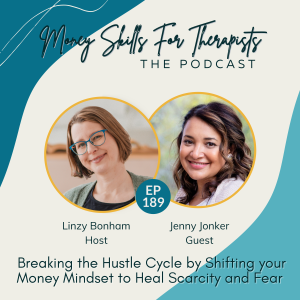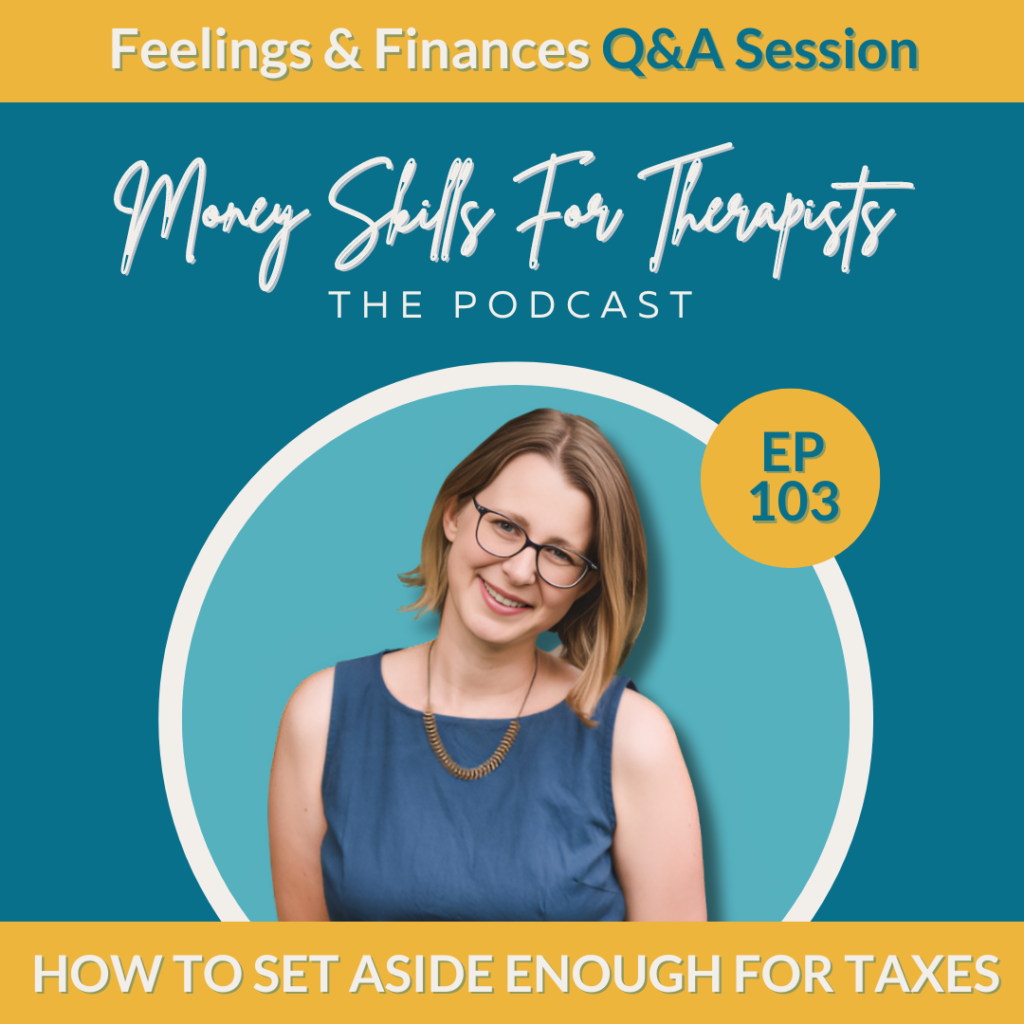[00:00:00] Linzy: Hello and welcome back to the Feelings and Finances mini podcast series, our second episode per week on the Money Skills for Therapists podcast. These short episodes are all about answering your questions about all things feelings and finances.
[00:00:21] And our question today is from another one of my wonderful team members, Christelle. Christelle is our operations and student care coordinator here at Money Nuts & Bolts. And, uh, let’s listen to her question.
[00:00:33] Christelle: Hello, Linzy, and hello, listeners of Money Skills for Therapists, the podcast. This is Christelle. I’m also part of Linzy’s team, and I am usually the one that speaks with potential students. When you reach out via email, you will speak with me. And so, Linzy, one of the questions that we hear I would say the most often, is how much to save for taxes.
[00:00:58] Like how much should we save? How much should we have aside as the year goes around? Like how to even start with this. Thank you.
[00:01:08] Linzy: As you mentioned, Christelle, this is a question that we hear all the time, about taxes. And this is actually one of the areas that I see the most confusion about business finances is this tax question because it’s one of these things that often I think we think that we understand it, but folks end up over saving.
[00:01:25] And I don’t want you to over save as weird as that sounds. So in terms of where to get started with taxes, saving for taxes, one of the most important things to understand is when you are putting aside your tax money, it is income tax that you are saving, which means that it’s taxes on the money that you actually get to take home.
[00:01:45] That means that the money that you spend to run the business, your operating expenses, you do not pay income tax on because it’s not your income, right? It’s business expenses. It’s operating expenses. So when you are looking at how much money to set aside for taxes, you’re not looking at that money coming in the door.
[00:02:03] That top number is where we often look to for putting aside what we think is our tax rate. But actually the number that you want to be setting aside from is what is left after you run your business. If you’re a sole proprietor the equation is like money come in the door minus operating expenses minus what it costs you to run the business, your business expenses.
[00:02:24] What is left? All of that is considered yours, regardless of whether or not you take it out of the bank account, and that is what you get taxed on, right? So let’s just say, you know, there’s a hundred percent on the top. If 20 percent of the money that you make goes towards operating expenses, goes towards your rent and paying for your EHR, advertising, it’s the 80 percent that’s left that you get taxed on.
[00:02:48] So if your tax rate is 30%, you actually need to set aside 30% of that 80%. Now, that’s where our brains can really start to hurt very quickly. And I remember when I was learning Profit First, which is a system that allows you to set aside money based on that top number. This equation of the like percent times percent always made me be like, wait a second, how do I do that?
[00:03:11] But one way that you can look at it is you’re going to take the money that’s left each month. So look at like a few months as an example, right? Let’s say in three months, your average money that you bring in the door is 10, 000. We’re going to use that for easy numbers. And when you look over those three months, the average that you’re spending on your business expenses ends up being that 20 percent we talked about.
[00:03:35] So $2,000. 8, 000 is what you actually get taxed on, so you’re going to take 8, 000 times your tax rate. Right? So, your tax rate is something that you can find out quite easily. It’s one of those things that we often feel like is this like vague, weird, confusing thing. But, using the power of the internet,
[00:03:53] quite quickly, you’re going to find a number that is good enough for your tax rates. So you can just search tax calculator for your state or your province or your country. And you’re going to put in what you expect to get paid this year, not what you’re bringing in the door, but what do you expect to be taking home this year?
[00:04:11] So let’s say this year I expect to bring in 120, 000 and I’m going to get paid 80. I’m going to put 80, 000 into that tax calculator and it is going to tell me my average tax rate. Now your average tax rate is what you want to look at because ideally, it’s good to just put aside the right percentage of money from the very beginning and not have to stop and check and be like, Oh, I’m making more money now.
[00:04:33] Maybe I need to save more taxes. Maybe I’ve gotten to a higher tax bracket. If you can sit down and project: Okay, this year thinking about all the highs and lows, thinking about what’s normal, thinking about my goals, I’m planning to make 80, 000 this year. See what your effective tax rate is at that 80, 000 mark.
[00:04:52] Now, if you’re American, you’re also going to have your self employment tax on top of that. So you’re going to look at your self employment tax. It’s seven point something, seven and change. You’re going to also want to think about putting that money aside. And if you’re Canadian, you have to pay your portion of CPP, the Canadian Pension Plan.
[00:05:09] And if you’ve opted in to employment insurance, EI, you also have to set aside your own EI, right? Because as a business owner, you are the employer and the employee. So you need to set aside the employer portion of these taxes, whichever country you’re in. And you also need to remit your own employee portion of it, right?
[00:05:27] Like you’re paying taxes for both the business and yourself, right? So you’re going to take a look at those numbers. When you put your numbers into the tax calculator, the number you’re going to get is going to be conservative. Conservative is not a bad thing, but if you see a number and you’re like, whoa, I cannot put aside that much for taxes and live on the rest.
[00:05:46] Then it’s a great time to go talk to your accountant, and ask them this question. Like I’m planning to make this much this year. How much should I actually be setting aside for taxes? Because they’re going to have your bigger financial picture. They’re going to know, you know, if you’re filing with your spouse, between the two of you, what you’re entitled to, what your tax rate is based on your combined income.
[00:06:04] There’s also a certain amount of deductions that everybody’s entitled to. So they’re going to be able to give you a much more accurate estimate. If that feels important to you, and if you have a good relationship with your accountant, you might as well ask them, might as well get that information. But if you don’t have an accountant yet, or if you don’t have a good relationship with your accountant.
[00:06:21] You should find a different accountant. That’s for a whole other episode. But just going to one of these tax calculators online and putting your numbers is going to give you a great place to start. And then it’s deciding for yourself a system to set money aside. Now I will say on this one I could literally talk about this for a whole hour and I have done that.
[00:06:38] I do have a workshop on how to set enough aside for taxes in a five simple steps. And I will link that workshop, actually, in the show notes because I’ve got a tool in there. I’ve got a calculator for you to be able to put in how much you earn and it will add on that like self employment piece, whether it’s like Canadian or American, there’s two different calculators.
[00:06:57] So I’ve got resources for you that are much more robust. If you want to dig into this question, if you want to get total clarity around your tax number, but I will say to start that biggest most important piece is understanding that you’re putting aside money based on what you earn, not everything that you bring in the door. It’s income tax. It’s only on your income, and once you get clear on how much to put aside, you can create a separate bank account system; you can send money off every month. Once you have been in business you will also be asked to make quarterly payments so you will at a certain point have it so that the government is like, “Hey, every quarter, I want you to give us this much money based on what you made last year.”
[00:07:36] If this year you’re making the same as last year, you can use those quarterlies as a guide and just remit whatever amount they tell you. But if you’re a newer in business, you’re not going to have that information yet. And that’s where using the tax calculator that I provide and looking up this information, checking out the workshop that I’m going to link in the show notes can be an extra resource to you when you are in that situation.
[00:07:56] So take the time. Get clear on these numbers. They don’t have to be a mystery. And once you know what the numbers are, then you can make a plan to actually be saving the amount of money that you need. This makes it so tax time is neutral to sometimes even positive, rather than a big stressor. So thank you so much, Christelle, for your question.
[00:08:15] And folks listening, if you want to hear more, check out the link in the show notes for that taxes workshop. I would love to hear from you with your questions. All you need to do to submit a question for the Feelings and Finances podcast series is to head over to our podcast page on our website.
[00:08:31] There’s a link in the show notes. Click on the little SpeakPipe logo. That’s our little tool where you can record your question, just introduce yourself, share your name. You can make up a name if you want. You can call yourself Unicorn Cupcake if you’d like, whatever. But I would love to hear your questions because it makes me happy to be able to chat with folks about these things.
[00:08:52] And my hope is that, for people listening and people who submit questions, this will give you some fuel to get moving, to help you shift things, to start to build a better relationship with money. Build out the systems that you need to take care of yourself and your family and your life. Money is an important tool to do that.
[00:09:08] So thank you so much for listening today.









